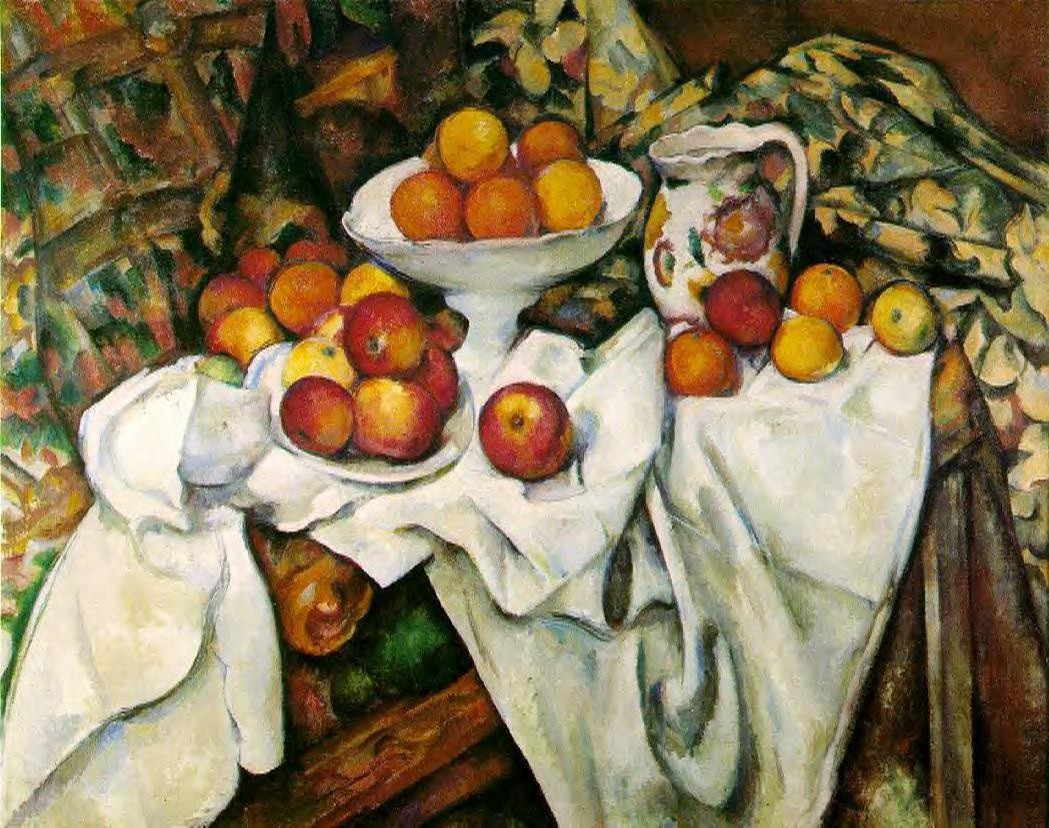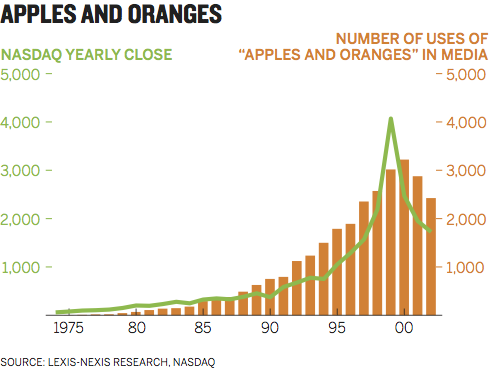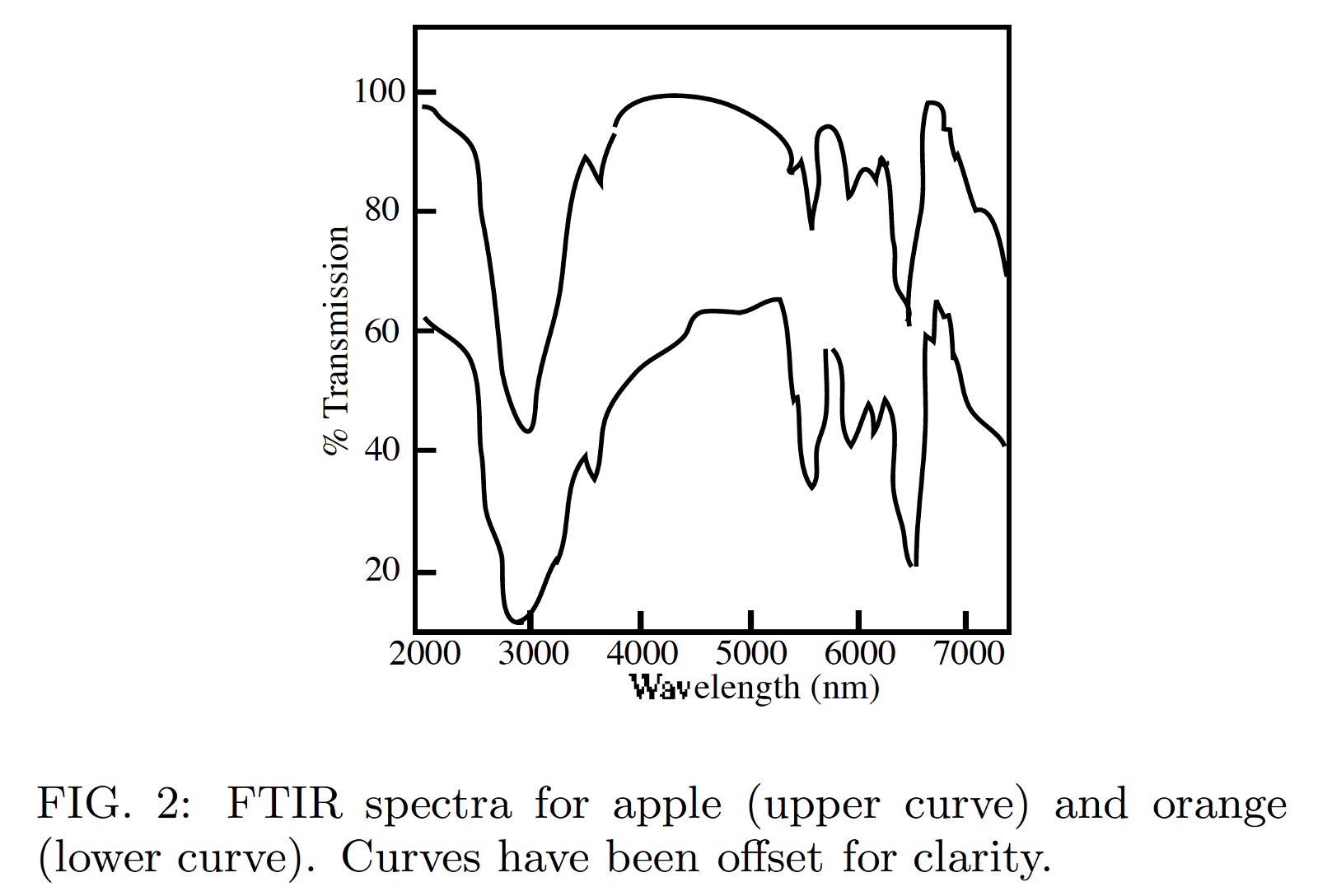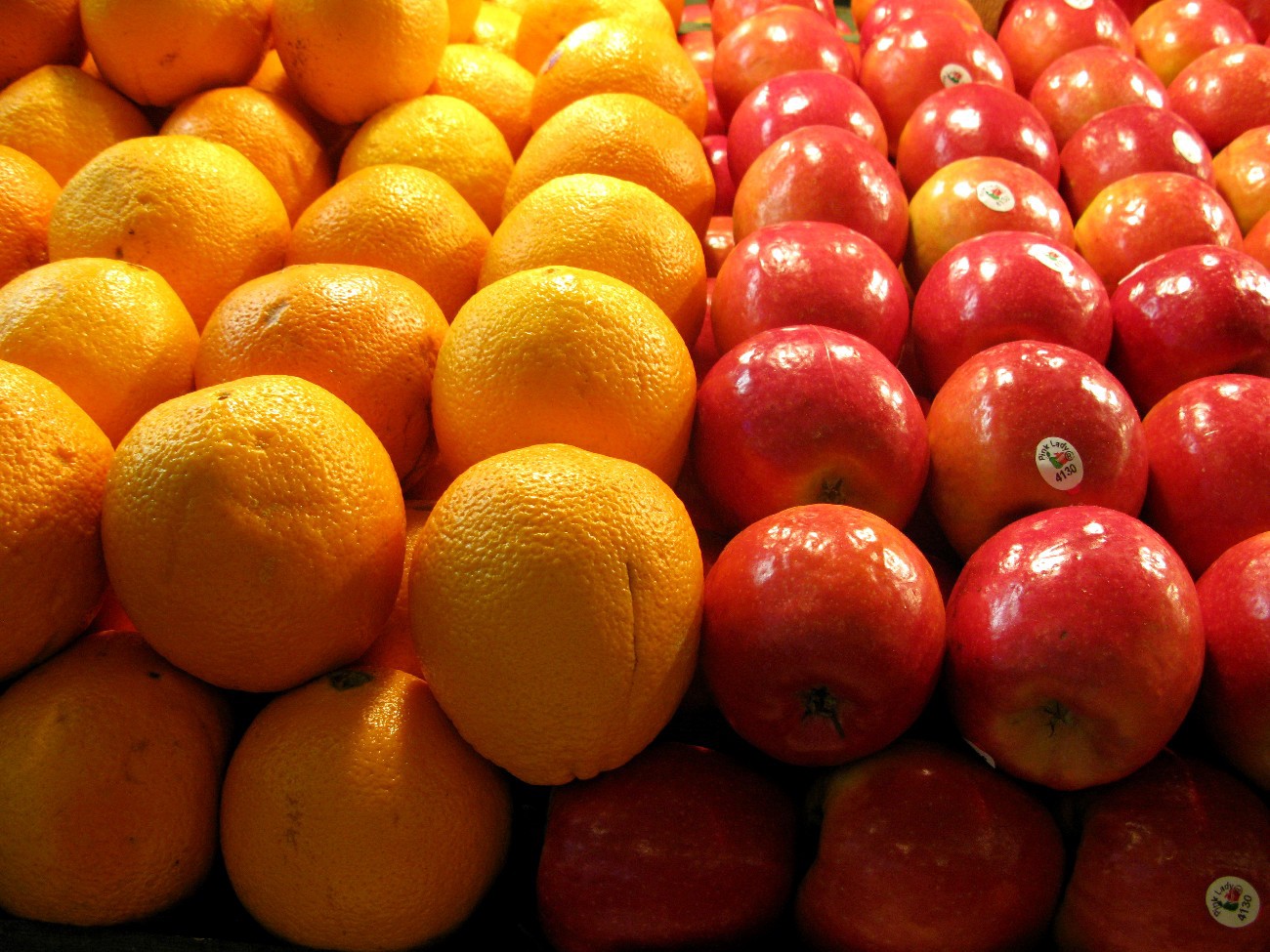 Comparing Cézanne to Monet is like comparing…
Comparing Cézanne to Monet is like comparing…
The phrase “apples and oranges” used to disqualify a comparison found its way into print twice so far today, February 22, 2002. One use came in an editorial in the Orlando Sentinel about funding for public broadcasting. The other was from USA Today, a business story about earnings, audits and (what else) Enron. The apples and oranges ploy is so ubiquitous that it has already been used in March even though that, as of this moment, March hasn’t happened yet. When it does, the March issue of Mortgage Servicing News will note that Australians make paying off loans a higher priority than Americans do, but “it’s also to a certain degree an apples and oranges comparison.”
So is the comparison between power contracts in California. So is the comparison between two nuclear waste task forces. So is the comparison between Apple’s and Intel’s processors. So is the comparison between numbers published by both Gartner and IDC on just how much the “B2B revolution” has stalled. So is the comparison of Kobe to Shaq for MVP.
Apples and oranges are pandemic. Last year the term was cited in the media 2,876 times, according to a Nexis search. Good news: this is down from 2000, when journalists and their sources used apples and oranges an unprecedented 3,220 times, or nearly nine times a day. Bad news: it’s the first time use of the term dropped year-to-year since it was first cited in Nexis, in 1975. That year, apples versus oranges was found only three times — first and most notably in the February 3, 1975 Business Week. Then-Treasury Secretary William E. Simon was being grilled on domestic oil price hikes versus OPEC oil prices. He told a reporter, “I think you’re comparing apples with oranges.”
It was used then as it is today: “Apples and oranges” is a stopper. It doesn’t advance one’s own position, it puts a cork in someone else’s. The person who uses it doesn’t want to make a comparison, so they simply discount the validity of one. They’re saying, “It’s not fair to make that comparison” and they probably think that, too. What they mean is, “I’m not sure I’d be comfortable with what that comparison tells me about the situation.” It establishes authority with zero accountability. It ducks the question and serves as the last word. It is a genius cop out.
It’s so common that it no longer requires exposition: “Apples and oranges, says the Bush White House.” And from a Fresno Bee letter to the editor: “In response to the letter comparing the current Enron scandal with President Clinton’s ‘problem’: apples and oranges.”
It’s used in serious situations — in 1977 the head of the Justice Department’s Criminal Division, Benjamin R. Civiletti, used the term in a Washington Post story comparing two concurrent investigations into congressmen receiving bribes from South Korean officials.
It’s also used in absurd situations — in 1990, sixth graders in Boise, Idaho, chose a cougar over Idaho’s state horse, the Appaloosa, for their school mascot. They did so because if they chose the horse, “we’re going to be called sissies.” one student said. “Who wants to be known as something with spots on their butts?” George Hatley, Idaho’s “Mr. Appaloosa” was aghast. He told the Lewiston Morning Tribune that in fact the cougars are the wimps. Comparing the feline’s fierceness to the Appaloosa’s, he said —it’s like comparing apples and oranges.
Apples and oranges is also a classic revocation of statistics. Damn statistics, which have a veneer of independent authority and can undermine an entire city, like Houston, recently declared the fattest city in America. Houston did not take this sitting on the couch. A Chronicle columnist proclaimed that comparing cities’ per capita girths was, you know, apples and oranges.
In a more serious feature, Grocery Headquarters Magazine used statistics to expose gender-salary discrimination in the industry. One source discounted the report, but not with countervailing statistics, or a cogent reason why the salary gap didn’t exist. She simply said that if it did exist, it didn’t mean anything, because comparing salaries between men and women is like comparing apples to oranges.
You know what’s rife with fruit? Letters to the editor (24 times in the past three months), where apples and oranges can make a large point in a small space. Apples and oranges is a beloved tool in college, rampant in term papers; professors use it to furrow their tenured brows, to suggest some bit of research is full of bull. In science, it’s a dare to match wits: “To talk about soy isolate proteins in the same breath as fermented traditional forms is a bit like comparing apples and oranges.” Lookit, if you want to argue about this, you’d better know your soy isolates.
On my Nexis search, the apples and oranges ploy was found in the sports pages and on the front page. It was found in Manila and Prague. It was noticeably absent from law publications and stories about the law. It seems the burden of proof requires more than a fruit metaphor.
The phrase took off in the business world around the mid-‘90s when the Nasdaq composite took off, and so did the number of business publications where the term might appear, like Business Times Singapore and the Wichita Business Journal, and web sites like TheStreet.com. But it was also found in the heavyweights like The Financial Times. It’s not surprising. Business is statistics, trends and the comparison of statistics and trends. Executives use apples and oranges to avoid talking about unpleasant truths.
To wit, when Carla Cico, the president of Brasil Telecom was asked by the Financial Times last November to compare the country’s telecom industry performance in 2001 to 2000, she said that would be like comparing apples and oranges, and thus avoided having to recount the grisly details of how poorly her industry had performed over the past year.
Market analysts love apples and oranges.
In September 2000, when Apple’s performance fell flat, and PC vendors slipped, too, a CNBC personality wondered if the entire computer industry was in trouble. (It was). No, apples to oranges comparison, said Merrill Lynch analyst Steve Fortuna, who explained himself by noting simply that Apple was a unique case. He didn’t say why. As for the other PC vendors tanking, Fortuna said that was because investors overreacted to Apple’s bad news. They couldn’t see an apple for an orange, as it were.
Two months later, when biotech stocks fell hard, CNBC anchor Ron Insana asked reporter Jane Wells if biotech would follow the dot-com trend. Apples to oranges, Wells said. Can’t compare the sectors. She was buoyed by an analyst who agreed and added that he thought that, unlike dot-coms, the nadir of the biotech collapse had been reached. He expected a rebound soon. The Dow Jones Biotechnology index was around 600 then. It’s around 400 now.
Along with the startling rise of apples/oranges’ use at this time came a notable rise in misuse. In some cases, apples and oranges came to be a way to simply halt a bothersome line of questions. Microsoft did this. When the company was hacked twice in one week, curious journalists asked if the attacks were related incidents. Microsoft spokesman Rick Miller said “They had nothing to do with each other. It’s like comparing apples and oranges.” But there was no comparison being made in the first place, never mind an invalid one.
 Correlation...
Correlation...
Use of apples and oranges peaked in the six month period between October 1999 and March 2000, when it was cited in Nexis 1,713 times. During the same six-month stretch, the Nasdaq composite rose from 2,736 and change to about 4,573. When the Nasdaq fell in 2001, so did use of the term. Nasdaq is down again this year, and apples to oranges use is projected to fall again, too, to about 2,500 citations.
Still, apples and oranges remains a highly overused copout, especially since Scott Sandford of NASA proved that it’s invalid. Six years ago.
In 1996, Sandford sliced a granny smith apple and sectioned a navel orange, dried them, mixed each with potassium bromide, milled them into a two piles of fine powder and pelletized the powder. He put the pellets under a spectrometer and measured their transmittance of infrared light. On this part of the spectrum, Sandford says, apples and oranges are basically the same color.
 That time Scott Sandford compared apples to oranges.
That time Scott Sandford compared apples to oranges.
And, overall, “They are dominated by the same molecules. All I wanted to show was that the bulk of both of these things is very, very similar. And I did,” says Sandford. His five-page research paper was published in the Journal of Improbable Research and it concluded that “the comparing apples and oranges defense should no longer be considered a valid argument.”
The Washington Post published his results in November, 1996. This seems prescient of the capital’s newspaper, but editors were just covering their asses: The Post loves apples and oranges. In fact, the metaphor has appeared in the Post more than 120 times after the paper published Sandford’s findings.
Apparently, Sandford’s research isn’t getting through, so let’s supplement his fine work with more, rather unscientific reporting.
Start with genetics. If the genes of a fruit fly and a human are 90 percent similar, apples and oranges must be nearly identical. Indeed they are, says Bob Koenig of the Institute for Genetic Research. But we can’t compare the two fruits’ genomes because, right now, no one is mapping them. The banana genome, that one’s being done (it’s more important in the global agricultural scheme), but who cares? Whoever says “that’s like comparing bananas and cumquats”?
Scott Boerner, my best friend and college roommate, is a molecular biologist now doing research at the University of Virginia. He said, “To say that something is ‘like apples and oranges’ as a way to try and signify differences is not impressive from a geneticist’s point of view. It would be much better to say ‘apples and quartz.’”
The problem with the apples and oranges ploy, and not just genetically, is that their differences are superficial at best, because both are fruits. But also because both grow on flowering trees (all fruits flower). Both have seeds. Both grow in two parts, the root stock and the scion. Both are roughly the same size, shape and weight. Both ripen. Both are sweet. You can peel both. You can drink the juice of both. Both come in several varieties. And both are important crops, no matter what the banana people say.
These similarities come from Dr. Gloria Moore, one of the nation’s top apple experts, from the department of pomology at the University of California-Davis. She also noted that both apples and oranges have played roles in history, literature and the arts. Classical still lifes often present both apples and oranges. In the west, the apple was in the Garden of Eden, and there is Johnny Appleseed. But oranges are similarly important to eastern religion and folkore. John McPhee’s book Oranges notes the fruit played roles in wars. And when Columbus came to the new world, he brought oranges.
Just to confuse matters, McPhee mentions that in Greek myth, the Golden Apples of the Hesperides were actually oranges.
Dr. Moore wanted to point out differences, too. Apples are malus, part of the rose family, and oranges are citrus, like lemons, limes and citron. They taste different. To tongues, they feel different, too. Apples are mealy and oranges scaly. Apples are climateric, they ripen with ethylene. Non-climateric oranges given ethylene will change color from green to orange, but the fruit won’t actually ripen. Oranges will stay ripe for a long time on their trees. Apples are ripe for an instant, fall off their trees, knock important physicists into genius, and then rot on the ground.
Moore went on, though none of this seemed to be helping to prove the flagrant misapplication of apples-to-oranges. If they weren’t pruned, Moore said, orange trees would grow much larger than apple trees. Oranges can’t stand cool weather, apples can’t do without it. Their skins are radically different, and they serve different purposes. Oranges graft so easily that you can grow orange trees with lemon seeds. Apples aren’t so adaptable.
Moore was kind and patient and she could have continued. But she admitted she was only mildly charmed by the subject, and she was somewhat befuddled.
She asked: “What’s wrong with comparing two similar-but-different things?”
 Side-by-side comparison... [photo:frankieleon, flickr]
Side-by-side comparison... [photo:frankieleon, flickr]
A sharp question and it brilliantly undercuts the entire apples and oranges copout tactic.
The problem with “that’s like comparing apples to oranges” is not that the fruits are too similar to signify irreconcilable differences, Moore argues. The problem is that it assumes it’s not fair to make comparisons without perfect analogs.
But isn’t it more desirable, in fact, to compare two different things than to compare something to itself? Do we really need to compare apples to apples? Or oranges to oranges? Using apples/oranges shouldn’t end the conversation, it should start a far more profound one about similarities and differences and what can be gleaned from them.
Scott Sandford of NASA is happy enough with that explanation. In fact, you get the sense from Sandford he wishes he never did the damn apples and oranges paper. He admits to having nightmares about his own obituary. He has devoted his life at NASA to studying how chemicals that rained down on the earth billions of years ago may have seeded the world with the materials to create life. He’s published 200 scientific papers on astrochemistry and the delicate intertwining of stellar dust and human existence. Comparing his serious work to that one stupid thing he did years ago on a lark, it’s a joke. It’s like comparing apples to quartz.
Notes:
Power Contracts: (National Public Radio’s All Things Considered, June 16, 2001); Nuclear Task Forces: (Nuclear Waste News, April 13, 2000); Megahertz speeds: (Network World, January 15, 2001); Stalled B2B Revolution: (Investors Business Daily, October 26, 2001); Kobe and Shaq: (Sporting News, March 4, 2002); Oil prices and OPEC: (Business Week, February 3, 1975); Brasil Telecom: (Financial Times, November 21, 2001); Says Bush White House: (Washington Post, February 26, 2000); Letter to Editor Fresno: (Fresno Bee, date); Manila Electric Co.: (Manila Standard, date); EU labor sanctions: (Prague Journal, date); South Korean scandal: (Washington Post, date, 1977); Apaloosas: (Lewiston Morning Tribune, October 3, 1990); Soy: (Townsend Letter for Docotors and Patients, Januray 1, 2002); Apple Performance: (CNBC transcript, September 2000); Biotech: (CNBC transcript, November 2000); Microsoft: (Network World, November 6, 2000); Nasdaq Composite and Dow Jones Biotechnology performance from Bigcharts.com; “Apples vs. Oranges” graphic courtesy of Scott Sandford; 2002 Usage of “apples and oranges” is projected; 2002 Nasdaq composite performance is through 2/22/02; Nexis searches were done on 2/22/02 using the “News Group File, All” database and searching three-month periods of each year using the term “apples and oranges.” Nexis sometimes turns up duplicate hits and there were a few, scattered citations in which the phrase was used properly, as part of a list, e.g., “they ate apples, oranges and bananas.” The duplicates and correct usages were part of the total count and were assumed to have statistically canceled themselves out.